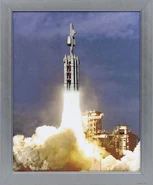The DY-100 class was an early design of Earth space vessels that were in operation during the late 20th century.
The ships were especially designed for interplanetary travel. They had simple nuclear powered engines and were equipped with artificial gravity. They still used transistors as components. DY-100 ships were launched into orbit with booster rockets. In the 1990s, this class of spaceship was considered to be one of the most advanced.
At least some of the DY-100 ships were sleeper ships. In those a crew of at least 85 could be placed into suspended animation inside life support canisters prior to liftoff. The life support of the ship was turned off for the journey. The use of suspended animation was necessary up to approximately 2018, as it took years to travel from planet to planet in the solar system prior to that.
The production of the DY-100 class ship began prior to 1996 and ended some time before the year 2000. A later generation of the class, the DY-500, was similar in configuration and some 23rd century Humans had trouble telling them apart. (TOS: "Space Seed")
A model of a DY-100 appeared on a window sill of the office where Rain Robinson worked, at the Griffith Observatory in California in 1996. She also had a photograph of the launch of a DY-100 attached with tape to a cabinet. (VOY: "Future's End") A photograph of the same DY-100 launch was in the 602 Club, along with many other space achievements, like the NX-Alpha, the Phoenix, and USS Enterprise (XCV 330). (ENT: "First Flight")
Ships commissioned
Template:DYTypeStarships
Appendices
Appearances
- TOS:
- "Space Seed"
- "The Ultimate Computer" (original version)
- VOY:
- "Future's End" (model, photograph)
- "Drone" (computer display)
- ENT:
- "First Flight" (photograph)
- "Home" (photograph)
Background
The DY-100 was designed by Matt Jefferies. In sketches it was referred to as an "obsolete tramp space freighter" or an "antique spacefreighter." One sketch also included the numbers 418 on the hull of the ship. Jefferies was pleased with the notion of modular shipping crates that could be automatically loaded and unloaded without requiring Humans to venture into space. In the sketches Jefferies envisioned that three additional cargo containers could be attached to complete the middle section arrangement. In fact, judging from the actual model, it appears that even a second set of containers could be attached behind the first. (The Art of Star Trek) In the original script of TOS: "Space Seed", this class was CZ-100. (Startrek.com) The model used in the post-TOS references was built by Greg Jein.
All of the DY-100 ships were probably not sleeper ships, as the crew of the Enterprise was surprised to discover the Botany Bay to be one. That contradicts a bit with the computer display of VOY: "Drone", where the image of the ship is specifically labeled "DY-100 Sleeper Ship".
The launch photo that appeared in VOY: "Future's End" was first seen in the Star Trek Chronology. It is also stated in the Chronology that significant improvements in sub-light propulsion technology led to abandoning of DY-100 ships.
Regarding the remastered version of the Botany Bay, according to Michael Okuda, "...the top of the 'conning tower' now has a tiny circular docking port, very similar to those used on the real-life International Space Station. The docking port was added at the suggestion of a former NASA engineer who noted that a spacecraft built in 1996 would probably have included such equipment to dock at the station." (Startrek.com)
The original version of "The Ultimate Computer" featured a DY-100 class Woden as a Federation freighter. This appearance would indicate some of these ships were adapted into service by the Federation and remained in use at least as far as the 23rd century. Due to the retcon of the remastered version it is impossible to determine if this was the case. Memory Alpha lists the Woden as an Template:ShipType starship, for the sole reason it was a more recent appearance from the production point-of view.
In Star Trek Spaceflight Chronology it is stated that DY-100 was the first mass-produced spaceship of Earth. This production began in 1996. There were cargo, fuel and passenger containers the ship could carry. In the standard configuration it was used between Earth and Luna. In an uprated mode it was able to take man to Mars. A journey to Mars, when the suspended animation was used, took 937 days. This is inconsistent with what is established in VOY: "One Small Step".
In the Spaceflight Chronology, timeline specifications are given of a SS Copernicus of the DY-100 class. It served from 1995 to 2020. Specification were length 100 meters, weight 2.72 million kilograms, ship's complement 22, and chemical/fission propulsion. Only the overall shape is similar to the Botany Bay. The Copernicus is probably intended to be the prototype of the class. Unlike the Botany Bay, the Copernicus had a built-in engine pack of six chemical boosters for liftoff. There is a discrepancy with the text and graphics as the graphics show only four boosters.
Apocrypha
In a short story in the 1977 Enterprise Log 4 comic book an unnamed DY-100 class ship was depicted with the registry number FWB 52. The ship was part of a fleet of DY-100 class ships that was used to colonize planets in the Sol system. [1]
External links
- Star Trek History Models and Bluescreen - behind the scenes bluescreen shots of various original series models, including the DY-100
- SS Botany Bay Miniature - photographs of the original model


